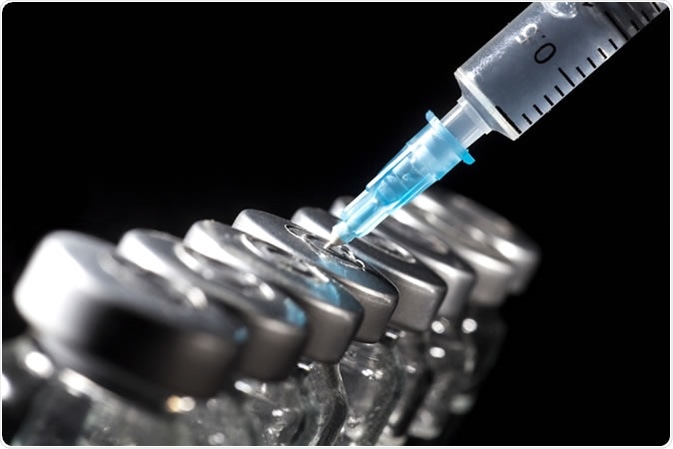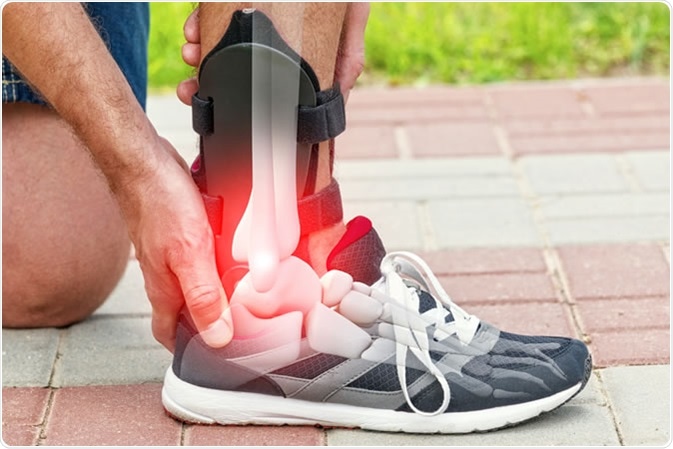Skip to:
Anabolic steroids can have many health benefits, including increasing pain tolerance, as well as strengthening and building muscle. Because of this, steroids have the potential to be used for treating various illnesses, diseases, or health complications, which also includes sports injuries.

Image Credit: Nikolay Litov / Shutterstock
Sports Injuries
Sports injuries are caused by accidents, insufficient warm-up, poor technique, or overexertion. Almost any part of the body can be injured while engaging in sports. The ankles and knees are especially prone to injury but muscles, bones, tendons, joints, and connective tissues can also be affected.

Image Credit: Monika Wisniewska / Shutterstock
Treating a mild sports injury usually involves resting the affected body part for the first 72 hours. Ice can be applied to the affected area to reduce swelling and painkiller medications such as ibuprofen or Tylenol/paracetamol can help to reduce the pain caused by the injury.
For more severe injuries, medical professionals may refer an individual to specialist treatment such as physiotherapy. Surgical intervention may also be required for some serious sports injuries, such as fixing fractured bones and repairing torn ligaments.
Preventing sports injuries is possible by taking necessary precautions into account when preparing for or engaging in exercise. Warming the body up before exercising and cooling down after exercise can aid with allowing the body to adjust to the start or end of exercise.
Learning the proper techniques of a specific exercise also reduces the risk of injury, as well as using the correct equipment for the exercises being performed.
An individual should also be aware of their current fitness level and limits to ensure they do not overexert themselves and cause injuries.
What are Anabolic Steroids?
Anabolic-androgenic steroids are synthetic variations of testosterone. Anabolic steroids have many uses in health care and sports.
Health care professionals can prescribe steroids to treat hormonal issues, including delayed puberty and Hypogonadism (testosterone deficiency syndrome).
Steroids can also be used to treat diseases that result in muscle loss such as cancer, peripheral neuropathy, multiple sclerosis, and AIDS. Some beneficial effects of anabolic steroid use include:
- Increasing lean body mass
- Decreasing body fat percentage
- Increasing muscle strength and power
- Increasing pain tolerance
- Enhancing recovery from injury
There are many more effects associated with steroid usage. Due to these beneficial effects, anabolic steroids are misused by some athletes to enhance performance during sports.
There are also adverse effects associated with the use of anabolic steroids, these include:
- Elevated blood pressure
- Male pattern baldness
- Impotence and transient infertility
- Increased risk of tendon tears
- Mood swings
- Depression
- Aggression
How Effective are Anabolic Steroid Treatments in Healthcare Settings?
The positive effects of anabolic steroid use can be exploited in healthcare settings to provide treatments for numerous illnesses, diseases, and health conditions.
Pressure ulcers are common in patients that are bedridden for prolonged periods. These ulcers, also known as bed sores, develop due to sustained pressure on the skin over bony parts of the body such as the hips, lower back, and elbows.
The most common treatment options for pressure ulcers are wound dressings and specially-designed beds/cushions that aim to reduce the pressure on certain areas of the body.
As anabolic steroids can increase muscle mass, they can be a potential alternative to conventional treatments for this condition.
A recent review aimed to evaluate the effects of anabolic steroids for treating pressure ulcers, by analyzing a random controlled trial (RCT) to compare the effects of anabolic steroids with alternative treatments.
The trial contained participants with spinal cord injuries and severe pressure ulcers split into two groups (one receiving steroids, the other receiving a placebo).
This particular study discovered that although the use of steroids carried no adverse side-effects, there was also no evidence to show that the use of anabolic steroids improved the healing of pressure ulcers.
The researchers concluded that “further well-designed, multicenter trials are necessary to assess the effect of anabolic steroids on treating pressure ulcers”.
Bell’s palsy is a type of peripheral facial paresis (muscle weakness) that causes partial paralysis of the affected side of the face. The causes of this illness are unknown. Analysis of multiple RCTs and controlled clinical trials (CCTs) were performed to evaluate the effectiveness of steroid-antiviral and steroid only treatments for Bell’s palsy.
The review analyzed approximately 8 papers (which included a total of 1,816 patients: 896 treated with steroid-antivirals and 920 treated with steroid-only). The study discovered that the steroid-antiviral group expressed an 83.6% recovery rate, whereas the steroid-only groups expressed a 76.8% recovery rate.
These results clearly show that both treatments are extremely effective, but the steroid-antivirals were the most effective treatments.
This demonstrated that healthcare professionals can consider steroid treatments as a potential alternative to existing treatments for Bell’s palsy.
Can Anabolic Steroids Treat Sports Injuries?
Unfortunately, research examining the effects of steroid use is limited due to the reluctance of some institutional review boards to approve anabolic steroid use on a non-clinical population.
This results in most investigations on this topic being performed on athletes that are self-administering the drugs. These athletes also take other medications and drugs that will lead to different effects, which makes the results of these studies less reliable.
The sports and physical activities that these athletes engage in makes them more prone to injuries which may further alter study results.
Anabolic steroids as treatments for contusion and strain injuries have been investigated using animals. This study used rat models with reproducible muscle contusion injuries. There were control, an anabolic steroid, and corticosteroid groups.
Initially, the corticosteroid group showed great improvements to twitch and tetanic strength, but later these improvement reversed and resulted in the degeneration of the muscle. The anabolic steroid group showed no initial improvements, but by 14 days showed significant improvements to twitch tetanic strength without the degeneration of the muscle. The authors concluded that that corticosteroids were helpful in the short-term but detrimental to long-term muscle repair and anabolic steroids could improve muscle repair and aid in the healing of muscle contusion injury.
Further studies and reviews have highlighted the significance of anabolic steroids for potentially aiding in repairing of damaged skeletal muscles following an injury. With anabolic steroid being shown to improve the natural muscle repair process and aid in the repairing of snake venom induce-muscle injury.
Anabolic steroids have also been shown to be very effective with aiding the repair of orthopedic injuries by directly aiding in skeletal repair and aiding in muscle repair which allows for the strengthening of bones.
Sources
- nhs.uk. (2019). Sports injuries. https://www.nhs.uk/conditions/sports-injuries/
- Drugabuse.gov. (2019). Anabolic Steroids. https://www.drugabuse.gov/publications/drugfacts/anabolic-steroids
- Hoffman, R. and Ratamess, N. (2006). Medical Issues Associated with Anabolic Steroid Use: Are They Exaggerated?. Journal of Sports Science and Medicine. https://www.ncbi.nlm.nih.gov/pubmed/24259990
- Naing, C. and Whittaker, M. (2017). Anabolic steroids for treating pressure ulcers. Cochrane Database of Systematic Reviews. www.cochranelibrary.com/cdsr/doi/10.1002/14651858.CD011375.pub2/full
- Beiner, J., et al. (1999). The Effect of Anabolic Steroids and Corticosteroids on Healing of Muscle Contusion Injury. The American Journal of Sports Medicine. https://doi.org/10.1177%2F03635465990270011101
- Carson, J. and Manolagas, S. (2015). Effects of sex steroids on bones and muscles: Similarities, parallels, and putative interactions in health and disease. Bone. https://dx.doi.org/10.1016%2Fj.bone.2015.04.015
Further Reading
Last Updated: Jul 24, 2023